WZ Sge is in Rare Superoutburst!
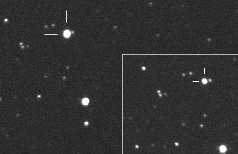 |
| WZ Sge went into a rare outburst on July 23, 2001. At bottom right, star appears about 1.5 mag. fainter as on Aug 10.8 UT. Credit: Gianluca Masi, Bellatrix Astronomical Observatory - Ceccano (FR), ITALY. |
WZ Sge - the prototype of the WZ Sge subclass of dwarf nova cataclysmic variables - went into a rare outburst on July 23, 2001 (see AAVSO Alert Notices 286 and 287) captivating the attention of amateur and professional astronomers around the globe. This outburst of WZ Sge has been monitored extensively by the astronomical community; with numerous satellite or ground-based observing campaigns already carried out, underway, or scheduled for the coming weeks and months. Since reaching maximum visual magnitude of approximately 8.0 on July 23-24, WZ Sge declined to about magnitude 10.7 by August 15. Then, after some anticipation, it began a dramatic "dip" of 2 magnitudes with a fast recovery (see Alert Notice 287) on August 16-17. The star faded to approximate magnitude 12.9 by August 18-19, and by August 21 had recovered to visual magnitude about 10.7. Since then it has been fluctuating between magnitudes 10.7 and 12.7. Figure 1 is a composite light curve showing the current outburst and the 1978 superoutburst of WZ Sge. It appears that this outburst is closely mimicking that of 1978! Presently there have been over 18, 300 observations submitted to the AAVSO during this outburst alone. The composite light curve is being updated daily on the AAVSO WZ Sge outburst update web page where you will also find curves of CCD runs on the WZ Sge superhumps, and other interesting links concerning this rare superoutburst.
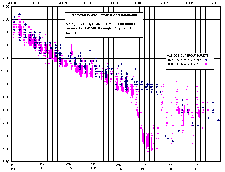 |
| Click image to enlarge Figure 1: AAVSO composite light curve of the 1978/2001 outburst (updated 8/31/01) |
A Little History
WZ Sagittae has had three recorded outbursts prior to the current one. The first maximum recorded occurred on November 22, 1913 and was discovered by J. Mackie while examining the Harvard photographic plates (Leavitt and Mackie 1919). The nova reached a maximum of magnitude 7.0 photographic. Named "Nova Sge 1913", the star was quiet for the next 33 years. It erupted again in 1946, discovered this time by Kurt Himpel, at the Heidelberg Observatory, in Germany on the night of June 28-29. During this outburst, WZ Sge climbed from 12th to 10th magnitudes in only 4 hours, reaching a maximum of 7.2 photographic on June 29, 1946. Following the outburst in 1946, WZ Sge was thought to be a recurrent nova. Since recurrent novae are roughly periodic, in 1978, observers of the AAVSO kept a close eye on WZ Sge in anticipation of another outburst. J. Bortle, who is one of the close followers of this variable, had observed it fainter than magnitude 14.5 on November 28.99 UT, 1978. Due to bad weather, however, he could not resume observations for three nights. On December 1.1 UT, 1978, 32.4 years after the second outburst, J.T. McGraw at the University of Texas discovered WZ Sagittae at visual maximum of about 8.0 magnitude (Patterson 1978). McGraw's discovery telegram on December 1 sparked an intensive worldwide effort to observe the star both spectroscopically and photometrically.
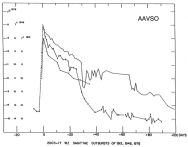 |
| Figure 2: Outbursts of 1913, 1946, and 1978 Click image to enlarge |
Figure 2 shows the mean light curves of the three outbursts in the history of WZ Sagittae. The light curves for 1913 and 1946 have been constructed from the photographic data published by Mayall (1946) and Campbell (1947). The daily means of the 1978 outburst are from visual and photoelectric (V) observations. The optical behavior of WZ Sge in general is similar during the three outbursts. It is interesting to note that both during the 1946 and 1978 outbursts a sharp decline in brightness took place about 30 days after maximum. A similar behavior is seen with the most recent outburst. One major difference between the 1946 and 1978 outbursts of WZ Sge is that, in the former, WZ Sagittae continued to decline after the abrupt fading, whereas during the outburst in 1978 it recovered within four days and oscillated for about 32 days before its gradual decline. This may be due to the lack of data for the 1946 outburst since the decline and recovery is fast, if there is no continuous data it would be easy to miss. The 2001 outburst appears to be most similar to the 1978 outburst; it is displaying this "dip" in brightness and currently appears to be oscillating by about two magnitudes.
WZ Sge Makes a Name for Itself
There are four types of non-magnetic cataclysmic (eruptive) variables: novae (see GK Per, Novae), recurrent novae (see RS Oph), dwarf novae (see SS Cyg, U Gem, Z Cam, SU UMa ) and nova-like objects. WZ Sge was originally classified as a nova because of its large amplitude outburst in 1913. Then, with the recurrence of large amplitude (~ 8 mag) outbursts of intervals of about 33 years (1913 and 1946), WZ Sge was re-classified as a recurrent nova. Photometric studies conducted during the quiescent periods of WZ Sge, however, revealed an orbital period of 81 minutes and 38 seconds, a short orbital period that is not usually seen in recurrent nova. In addition, through spectroscopic observations made during the 1978 outburst, it was proved that WZ Sge displayed characteristics more similar to a dwarf nova than a recurrent nova. The spectra showed a mostly featureless continuum at maximum similar to the U Gem variables instead of broad emission bands and P Cyg absorptions that are seen with recurrent novae (S. Ortolani et al., 1979). Observations of the 1978 outburst also revealed photometric light variations in WZ Sge called "superhumps". These superhumps are the defining characteristics of SU UMa type dwarf novae and so WZ Sge is considered the prototype for a subset of these SU UMa type stars.
Dwarf Novae:
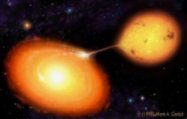 |
| Artist's conception of a close binary system. Credit: Mark A. Garlick (http://space-art.co.uk) |
WZ Sge and SU UMa, like all cataclysmic variables, are close binary systems consisting of a late-type star that fills its inner Lagrangian surface (stability limit for two components) and transfers material onto an accretion disk formed around the companion white dwarf. The region where the stream of ejected material strikes the disk is called the "hot spot". It is interactions within the disc that give rise to "normal" outbursts typically seen in dwarf novae. Currently, the most favored theory that explains these outbursts is the, "Disk-Instability Model". In this model, the mass transfer from the secondary is relatively constant, but the accumulated gas in the outer portions of the disc give rise to thermal instabilities which cause matter to be accreted onto the white dwarf which then causes an outburst.
SU UMa stars:
SU UMa stars are a type of dwarf novae that exhibit two clearly defined distinguished types of outbursts, a short outburst called a "normal outburst" (due to thermal instabilities within the disc as described above) which lasts for a few days and long outbursts called "superoutburst" which lasts typically for two weeks or so. SU UMa stars have short orbital periods, in almost all cases, below the "CV period gap" (between 2 and 3 hours) and they exhibit the periodic photometric light variation called "superhumps" during and only during superoutbursts (Osaki, Y. 1995). The mechanism behind superoutbursts, may be explained by the "thermal-tidal instability model" (Osaki 1996). In this model, in addition to thermal instabilities within the disk, a tidal instability also occurs. Physical processes cause the disk radius to expand until it reaches a critical radius whereby a 3:1 resonance is achieved and tidal instabilities produce the superoutburst, which returns the disk back to its "normal" size. For more information on SU UMa stars visit the VSOTM for SU UMa.
WZ Sge stars:
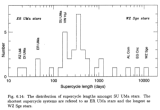 |
| Click image to enlarge Distribution of supercycle lengths among SU UMa stars. Credit: Hollier, C. (2001) Ch.6, p.88, Fig.6.14 |
The period of time from one superoutburst to the next is called the "supercycle". The supercycle lengths of the known SU UMa stars are mostly around a few hundred days, but a few systems have much shorter or much longer supercycles. The short-supercycle systems have become known as ER UMa stars, while the long-supercycle systems are called WZ Sge stars. ER UMa stars typically spend a third to half their time in superoutburst, with a supercycle of only 20-50 days. When not in superoutburst these stars show frequent "normal" oubursts - about one every 4 days. In contrast, WZ Sge stars have supercycles that last decades, while normal outbursts are few and far between. WZ Sge itself has had a superoutburst at intervals of about 33, 32, and 23 years, and it has never been seen to undergo a normal outburst. Other WZ Sge type stars include AL Com and EG Cnc which have superoutburst intervals of approximately 20 years.
The approximately 30-year supercycle length that WZ Sge displays is the most inactive group of the SU UMa type stars. The factor determining the different timescales appears to be mass-transfer rate. WZ Sge stars have a very low mass-transfer rate, perhaps only 1012 kg/s. Given the slow rate of mass-transfer, it would then take decades to accumulate enough material for a superoutburst. The puzzle of these stars, however, is why they show few or no normal outbursts during this interval. Even with a low mass-transfer rate, material should accumulate, drifting viscously into the inner disc, and trigger an outburst. One suggestion for why this does not occur is that the disc viscosity is very low. The material would then remain in the outer disc, where much more can be stored before an outburst is triggered. The problem with this idea, however, is to explain the extremely low viscosity level. Another possible explanation involves the removal of the inner disc, to prevent outbursts starting there. This could occur through "siphons" or because of a magnetic field on the white dwarf (Lasota et al. 1995, Warner et al. 1996, Hameury et al. 1997, Meyer-Hofmeister et al. 1998, Lasota et al. 1999).
What Causes Superhumps?
During the 2001 superoutburst of WZ Sge, significant superhump activity was recorded by AAVSO observers and several good examples of these light curves can be found on the WZ Sge page. Superhumps are the hump-shaped modulation that appears during superoutburst. The period of the humps is a few percent longer than the orbital period. They continue until the star returns to quiescence, although their period usually drifts to slightly shorter periods and smaller amplitudes over time.
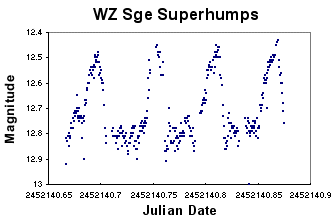 |
| Superhump light curve of WZ Sge during the 2001 superoutburst. Photometry by AAVSO Observer, Lew Cook (COO). |
The following description is from C. Hellier, 2001:
Nicholas Vogt was the first to propose that superhumps were caused by the disc becoming elliptical during superoutburst. He suggested that such a disc would precess, meaning that the direction in which the disc was elongated would gradually rotate, on a timescale much longer than the orbit (in the same way, the axis of a spinning top precesses, but more slowly than it spins). The long precessional period of the disc would then interact with the orbital cycle to create a new periodicity - the superhump. To see this, consider the secondary lining up with the elongated radius of an elliptical disc, which precesses with a period of a few days. One orbital cycle later, the secondary would again be in the same place, but the elongation would have moved on slightly, so the secondary would have to continue a little further before they again lined up. Any interaction between the two (such as the mass-transfer stream interacting with the disc) would thus occur at a slightly longer "superhump" period that can be considered the beat period between the orbital and precessional periods.
Is that a spiral I see?
 |
Image of the accretion disk in WZ Sge during the first week of its superoutburst, derived from optical spectroscopy. (Click image to enlarge.) Credit: Dr Danny Steeghs, University of Southampton |
During the first week of WZ Sge's recent superoutburst, D. Steeghs and T. Marsh of Southampton University; E. Kuulkers of the Space Research Organization Netherlands and Utrecht University; and W. Skidmore of the University of St. Andrews, on behalf of a larger collaboration, report the detection of strong spiral waves present in the accretion disk of this system (see IAUC 7675). This is the first time that spiral arms have been detected in WZ Sge and they are encouraging follow-up spectroscopy to track the evolution of the structures.
A Call for Observations
As mentioned in AAVSO Alert Notice 287, observers are requested to continue to monitor WZ Sge throughout the rest of this very rare superoutburst and particularly after the star returns to minimum (in the 1978 superoutburst, it took about 3 months after the dip for WZ Sge to return to minimum). Both visual and particularly CCD observers are urged to continue to monitor it for superhumps by making observations every 3 to 5 minutes for several hours; be sure to report the time to 4 decimal places of the Julian Date. Extremely fast CCD photometry (less than 1 minute exposure to exposure, preferably less than 30 seconds) in the last stages of the superoutburst and after return to minimum has been urged by Dr. T. Marsh, University of Southampton, UK.
AAVSO Charts are available for observing WZ Sge as well as precision photometry of the comparison stars. Please report your observations to AAVSO Headquarters, making sure to indicate which comparison star(s) you used.
WZ Sagittae, which is believed to be near the end of its lifetime as a cataclysmic variable (Robinson et al. 1978), challenges both the observers and theoreticians who are trying understand the behavior and evolution of these stars.
For More Information
- Campbell, L. 1947, Popular Astronomy, 55, 220.
- Green, D. IAU Circular No. 7675, July 31, 2001.
- Hameury, J.-M., et. al. "A Model for WZ Sge with 'Standard' Values of alpha", Monthly Notices of the Royal Astronomical Society, 287, 937-940, 1997.
- Hellier, C. "Chapter 6: Elliptical Discs and Superoutbursts", Cataclysmic Variable Stars: How and Why they vary, Springer-Praxis, London, 2001, 75-95.
- Lasota, J.P. et al. "Dwarf novae at low mass transfer rates", Astronomy and Astrophysics, 302, L29-L32, 1995.
- Lasota, J.P. et al. "WZ Sagittae as a DQ Herculis star." Monthly Notices of the Royal Astronomical Society, 305, 473, 1999.
- Leavitt, H.S. and Mackie, J.C., Harvard College Observatory Circular, No. 219., 1919.
- Mattei, J.A. "Variable Star Notes." Journal of the Royal Astronomical Society of Canada, 74, No.1, 1980, 53-55.
- Mayall, M. "Nova Sagittae 1913, another recurrent nova." The Astronomical Journal, 52, 1947, 127-128.
- Mayall, M.W., Bulletin of Harvard College Observatory, No. 918, 3, 1946.
- Meyer-Hofmeister, E., et al. "WZ Sagittae - an old dwarf nova." Astronomy and Astrophysics, 339, 507-517, 1998.
- Ortolani, S., Rafanelli, P., et. al. "The Recent Outburst of the Dwarf Nova WZ Sagittae." Astronomy and Astrophysics, 87, 1980, 31-35.
- Osaki, Y. "The Disk Instability Model of SU UMa Stars: Connection Between the SU UMa Stars and the WZ Sge Stars." Cataclysmic Variables, A. Bianchini et al. (eds.), 1995, 307-313.
- Patterson, J., McGraw, J., et al. "A Photometric Study of the Dwarf Nova WZ Sagittae in Outburst." The Astrophysical Journal, 248, September 15, 1981, 1067-1075.
- Robinson, E.L., Nather, R.E. and Patterson, J., Astrophysical Journal, 219, 168, 1978.
- Skidmore, W., Mason, E., et al. "Investigating the structure of the accretion disc in WZ Sge from multiwaveband time-resolved spectroscopic observations - I." Monthly Notices of the Royal Astronomical Society, 318, 2000, 429-439.
- Warner, B., et. al. Dwarf nova outbursts in truncated accretion discs: down with low alphas", Monthly Notices of the Royal Astronomical Society, 282, 735, 1996.
- Warner, B. 1976 in IAU Symposium 73, "The Structure and Evolution of Close Binary Systems", ed. P. Eggleton, S. Mitton, and J. Whelan. p.85
This month's Variable Star of the Month was prepared by Kate Davis, AAVSO Technical Assistant, Web.

